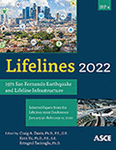A Seismic Fragility Framework for Earth Dams
Publication: Lifelines 2022
ABSTRACT
Seismic fragility models predict the probability of different damage states for a given earthquake intensity measure. This paper outlines a seismic fragility framework for earth dams, which uses the relative crest settlement as the engineering demand parameter and involves two statistical models: (1) an engineering demand model that predicts the relative settlement as a function of ground motion intensity, and (2) a seismic capacity model that predicts the probability of a damage state given the relative settlement. These two models are used together within a Monte Carlo simulation to compute the resulting fragility model. This paper focuses on developing seismic capacity relationships that are based on the original damage description for each dam without consideration of the observed relative settlement. The development of a seismic fragility model is demonstrated through an example that uses the proposed seismic capacity relationships and a simplified engineering demand model.
Get full access to this article
View all available purchase options and get full access to this chapter.
REFERENCES
Celik, O., and Ellingwood, B. (2010). Seismic Fragilities for Non-Ductile Reinforced Concrete Frames - Role of Aleatoric and Epistemic Uncertainties. Structural Safety, 32, 1-32.
Cornell, C. A., Jalayer, F., Hamburger, R. O., and Foutch, D. A. (2002). Probabilistic Basis for 2000 SAC Federal Emergency Management Agency Steel Moment Frame Guidelines. Journal of Structural Engineering, 526-533.
Donahue, J. L., Amini, Z. A., Hunt, C. E., Rix, G. J., and Umberg, D. R. (2018). Development of a Seismic Risk Screening Tool for Earthen Embankments. Geotechnical Earthquake Engineering and Soil Dynamics V: Slope Stability and Landslides, Laboratory Testing, and In Situ Testing, GPS 293, p. 27-36.
Ellsworth, W. L. (2013). Injection-Induced Earthquakes. Science, 341. doi:https://doi.org/10.1126/science.1225942.
Fell, R. B. (2000). The Status of Methods for Estimation of the Probability of Failure of Dams For Use in Quantitative Risk Assessment. International Commission on Large Dams 20th Congress. Beijing, China.
Hunt, C. E., Umberg, D. R., Rix, G. J., and Amini, Z. (2018). Seismic Risk Screening of Embankment Dams. 38th Annual Conference of the U.S. Society on Dams.
Khosravikia, F., Kurkowski, J., and Clayton, P. (2019). Fragility of Masonry Veneers to Human-induced Central U.S. Earthquakes using Neural Network Models. Journal of Building Engineering.
McCoy, J., Shurbet, M., Gilmore, R., Tinsley, W., Potts, M., and Illig, C. (November 1973). Engineering Data on Dams and Reservoirs in Texas Part II. Texas Water Development Board.
Nielson, B. G. (2007). Analytical Seismic Fragility Curves for Typical Bridges in the Central and Southeastern United States. Earthquake Spectra, 615-633.
Padgett, J. E. (2008). Methodology for Development of Analytical Fragility Curves for Retrofitted Bridges. Earthquake Engineering and Structural Dynamics, 1157-1174.
Pells, S., and Fell, R. (2002). Damage and Cracking of Embankment Dams by Earthquakes and the Implications for Internal Erosion and Piping. The University of New South Wales, School of Civil and Environmental Engineering.
Porter, K., Kennedy, R., and Bachman, R. (2006). Developing Fragility Functions for Building Components for ATC-58.
Ramanathan, K. N. (2012). Next Generation Seismic Fragility Curves for California Bridges Incorporating the Evolution in Seismic Design Philosophy. Georgia Institute of Technology.
Swaisgood, J. (2003). Embankment Dam Deformations Caused by Earthquakes. 2003 Pacific Conference on Earthquake Engineering.
Swaisgood, J. R. (1998). Seismically-induced deformation of embankment dams. In proceedings of sixth national conference on earthquake engineering. Seattle, Washington U.S.A.
Taylor, J., Çelebi, M., Greer, A., Jampole, E., Masroor, A., Melton, S., and Xiao, Y. (2017). EERI Earthquake Reconnaissance Team Report: M5.0 Cushing, Oklahoma, USA Earthquake on November 7, 2016. Oakland, CA, USA: EERI.
Weingarten, M., Ge, S., Godt, J., Bekins, B., and Rubinstein, J. (2015). High-rate injection is associated with the increase in U.S. mid-continent seismicity. Science, 1336–1340.
Yan, L. (1991). Seismic Deformation Analysis of Earth Dams: A Simplified Method. Pasedana, California Institude of Technology.
Information & Authors
Information
Published In
History
Published online: Nov 16, 2022
Authors
Metrics & Citations
Metrics
Citations
Download citation
If you have the appropriate software installed, you can download article citation data to the citation manager of your choice. Simply select your manager software from the list below and click Download.
